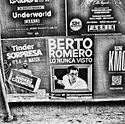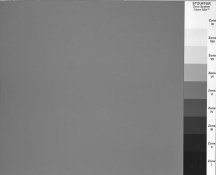Handy burning tool:
When I have to burn in small stubborn areas like unwanted highlights, I use a mechanic's flashlight with a long bendable "neck" with a tiny bulb at the end (available from some hardware stores and auto parts shops.) From small pieces of black plastic tubing, I made a handful of slip-on caps. Each cap has a small circle of Multigrade filter glued on one end. Depending on the kind of burning in needed, I simply slip on a numbered cap on the end of the flashlight, and away I go.
Not-so-opaque dodging wand:
I get better control of dodging print areas by using pieces of wire screen cut in the usual shapes (circle, oval, rectangle, star) instead of black opaque material. The "see-through" screen allows me to see just where exactly on the print I have dodged. Also, the wire screen acts like a kind of diffuser as light goes through it, and the result is that the dodged area looks more natural compared to when using an opaque dodging tool.
Flexible magnetic strips for test strips:
Oftentimes the print area to test is inconveniently located relative to the placement of the easel blades. I print exclusively in fiber, and in the dry Southern California air its a major struggle to get fiber to lie flat! To hold down small pieces of fiber paper, I use strips of flexible magnetic material (the kind you get in cheap calendars and promo items that you stick on refrigerators.) They cut easily with scissors. I rubber-cement wood tabs at the end of each magnetic strip to make them easier to pull off from the easel. The strips are rather thin, and sometimes hard to remove, so the pull tabs are useful.
Burn-in boards and Beseler MX series enlargers:
When printing relatively small sizes (8x10's from 4x5 negs, for instance) the bellows track of MX series enlargers end up too close to the easel, and often get in the way of customary rectangular burn-in boards. As you use the board to burn in different areas, more likely than not, you'd bump the protruding part of the enlarger. My solution is to this is to have semi-circular cutouts on one edge of all my burn-in boards. This way I can manipulate the boards without bumping the extended portion of the bellows track.
Pre-flashing data:
I keep pre-flashing exposure data on an index cards taped alongside my enlarger so that I have a ready reference. I test the types of paper that I use in one darkroom session, standardizing on lens and exposure. I list the brand and surface type of the paper, print size/enlarger height (8x10, 11x14, 16x20), and exposure data.













 .
.
